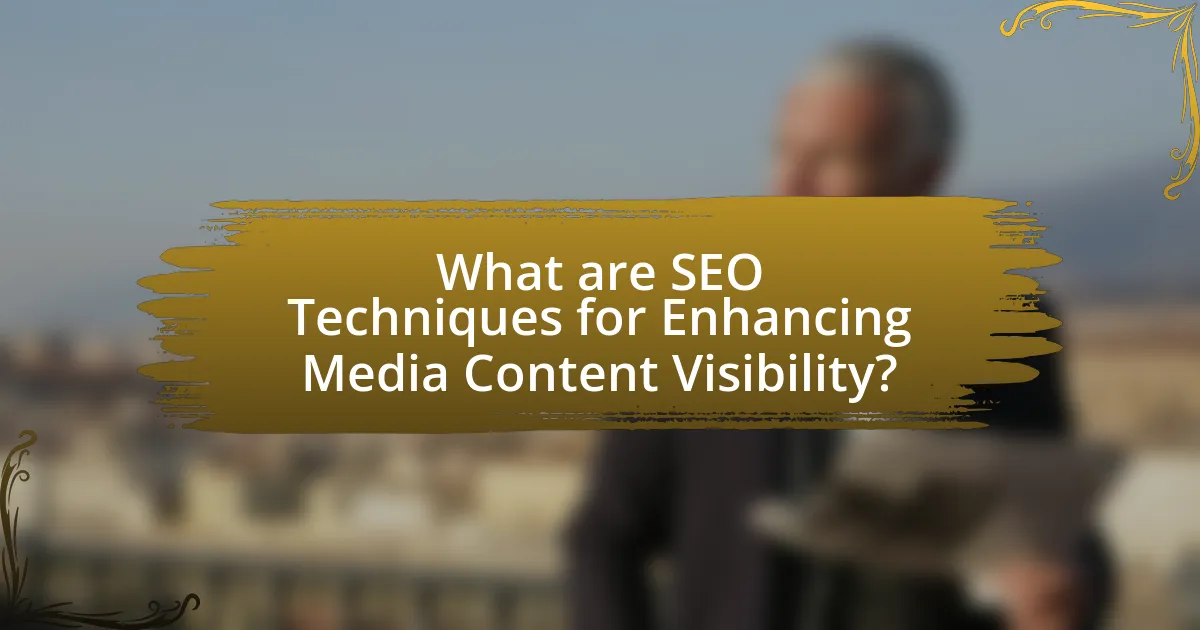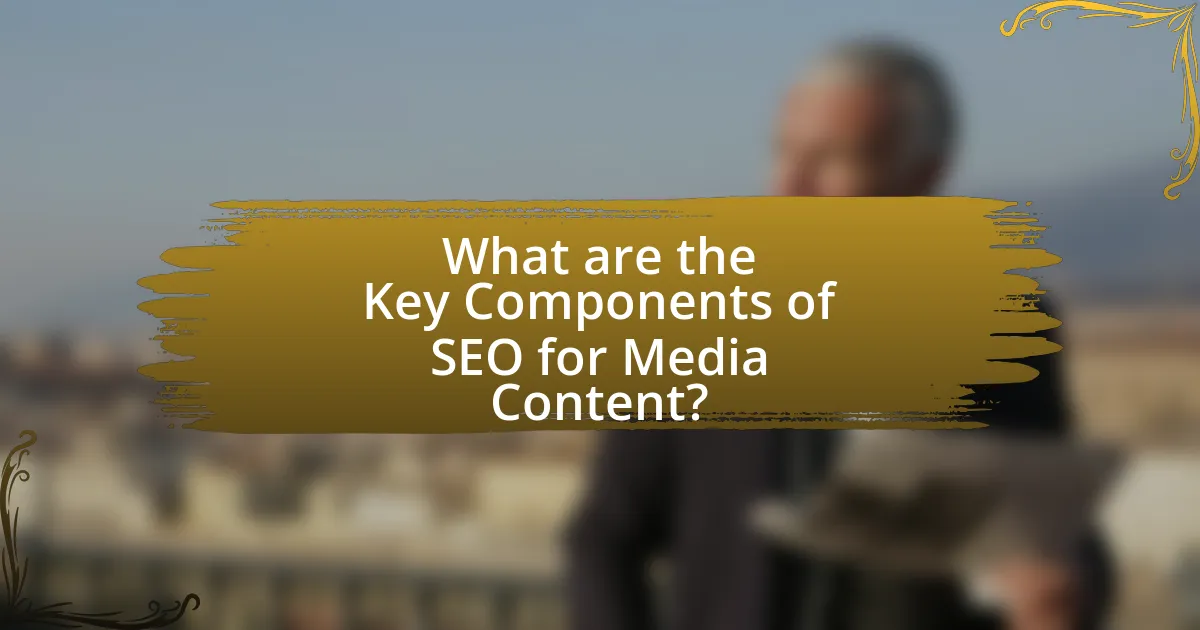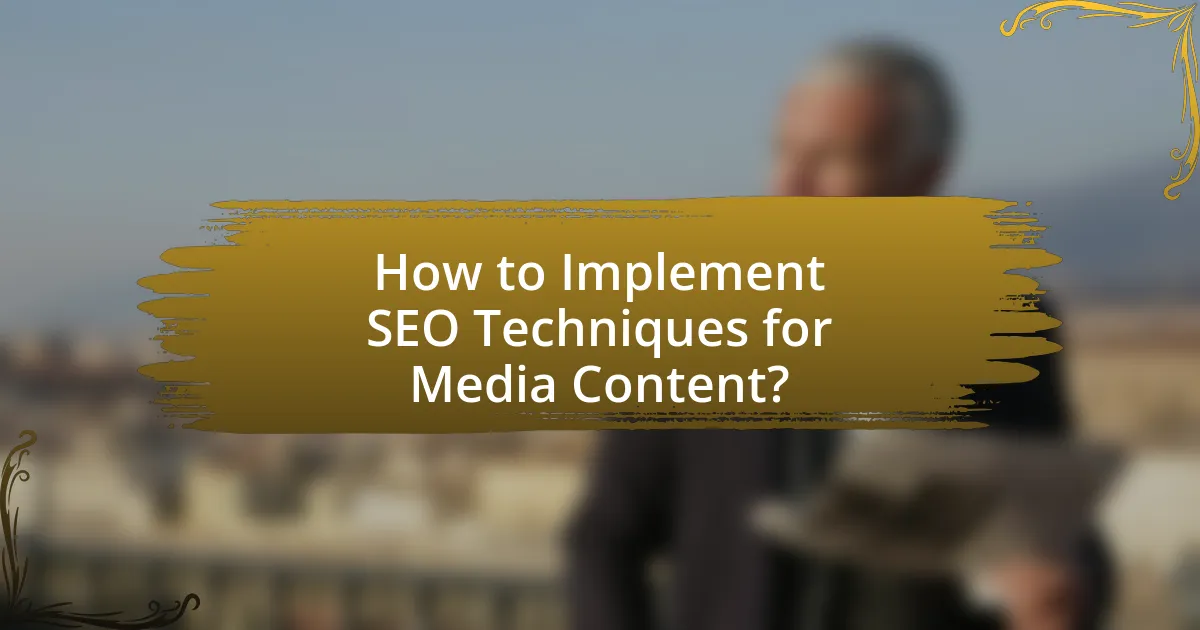The article focuses on utilizing SEO techniques to enhance the visibility of media content. It outlines essential strategies such as optimizing metadata, using descriptive file names, implementing alt text for images, and ensuring mobile-friendliness to improve search engine rankings. The discussion includes the impact of keyword research, on-page optimization, and the importance of user engagement metrics on visibility and conversion rates. Additionally, it addresses the differences between modern SEO practices and traditional methods, emphasizing the significance of creating user-centric content. The article also highlights best practices for maintaining SEO effectiveness and the metrics necessary for assessing performance.

What are SEO Techniques for Enhancing Media Content Visibility?
SEO techniques for enhancing media content visibility include optimizing metadata, using descriptive file names, implementing alt text for images, and ensuring mobile-friendliness. Metadata, such as title tags and meta descriptions, should contain relevant keywords to improve search engine rankings. Descriptive file names help search engines understand the content of the media, while alt text provides context for images, aiding accessibility and SEO. Additionally, ensuring that media content is mobile-friendly is crucial, as mobile optimization is a ranking factor for search engines. According to Google, mobile-friendly websites are prioritized in search results, making this technique essential for visibility.
How do SEO techniques improve media content visibility?
SEO techniques improve media content visibility by optimizing content for search engines, which increases the likelihood of appearing in relevant search results. By implementing keyword research, content optimization, and metadata enhancement, media content becomes more discoverable. For instance, using targeted keywords in titles and descriptions can lead to higher rankings on search engine results pages (SERPs), as evidenced by a study from Moz indicating that the first page of Google captures 71% of search traffic clicks. Additionally, optimizing images with alt text and proper file names enhances accessibility and indexing, further boosting visibility.
What specific SEO techniques are most effective for media content?
Effective SEO techniques for media content include optimizing metadata, utilizing descriptive file names, implementing schema markup, and ensuring mobile-friendliness. Metadata, such as title tags and alt text, enhances search engine understanding and improves visibility; for instance, images with descriptive alt text can increase organic traffic by up to 45%. Descriptive file names help search engines index content accurately, while schema markup provides structured data that enhances search results with rich snippets, improving click-through rates. Additionally, ensuring that media content is mobile-friendly is crucial, as over 50% of global web traffic comes from mobile devices, making responsive design essential for user engagement and SEO performance.
How do these techniques differ from traditional SEO practices?
These techniques differ from traditional SEO practices primarily in their focus on user experience and content quality rather than solely on keyword optimization and backlinks. Traditional SEO often emphasizes ranking factors like keyword density and link quantity, while modern techniques prioritize engaging content, user intent, and mobile optimization. For instance, Google’s algorithm updates, such as the Core Web Vitals, highlight the importance of page loading speed and interactivity, which are not central to traditional SEO methods. This shift reflects a broader trend towards creating valuable, user-centric content that meets the needs of the audience, thereby enhancing media content visibility more effectively.
Why is media content visibility important for online success?
Media content visibility is crucial for online success because it directly influences audience engagement and brand recognition. When media content is easily discoverable through search engines and social platforms, it attracts more viewers, leading to increased traffic and potential conversions. According to a study by HubSpot, 75% of users never scroll past the first page of search results, highlighting the importance of optimizing content for visibility. Enhanced visibility not only drives organic traffic but also establishes authority and trust, as users are more likely to engage with content that appears prominently in search results.
What impact does visibility have on audience engagement?
Visibility significantly enhances audience engagement by increasing the likelihood that content will be discovered and interacted with. When media content is optimized for search engines, it appears higher in search results, leading to greater exposure. According to a study by HubSpot, 75% of users never scroll past the first page of search results, indicating that higher visibility directly correlates with increased audience interaction. This relationship underscores the importance of SEO techniques in improving content visibility, which in turn fosters higher engagement rates.
How does increased visibility affect conversion rates?
Increased visibility directly enhances conversion rates by attracting more potential customers to a website or platform. When a brand or product is more visible, it reaches a larger audience, which statistically increases the likelihood of user engagement and purchase decisions. For instance, a study by HubSpot found that companies that prioritize SEO and improve their visibility can see conversion rates increase by up to 14.6%, compared to traditional outbound methods, which have a conversion rate of only 1.7%. This correlation between visibility and conversion rates underscores the importance of effective SEO techniques in driving traffic and ultimately boosting sales.

What are the Key Components of SEO for Media Content?
The key components of SEO for media content include keyword optimization, metadata utilization, content quality, user engagement, and mobile optimization. Keyword optimization involves researching and incorporating relevant keywords into titles, descriptions, and tags to enhance discoverability. Metadata utilization, such as alt text for images and video descriptions, helps search engines understand the content context. High-quality content that provides value to users increases dwell time and reduces bounce rates, which positively impacts rankings. User engagement metrics, including shares and comments, signal content relevance and quality to search engines. Finally, mobile optimization ensures that media content is accessible and performs well on mobile devices, which is crucial as mobile traffic continues to rise, accounting for over 50% of global web traffic according to Statista.
How does keyword research influence media content visibility?
Keyword research significantly influences media content visibility by identifying the terms and phrases that potential audiences use to search for relevant information. By targeting these keywords, content creators can optimize their media for search engines, improving the likelihood of appearing in search results. For instance, a study by Ahrefs found that 90.63% of web pages receive no organic traffic from Google, highlighting the importance of effective keyword targeting to enhance visibility. Proper keyword research ensures that content aligns with user intent, thereby increasing engagement and driving traffic to the media.
What tools can be used for effective keyword research?
Effective keyword research can be conducted using tools such as Google Keyword Planner, SEMrush, Ahrefs, and Moz. Google Keyword Planner provides insights into search volume and competition for keywords, making it essential for identifying relevant terms. SEMrush offers comprehensive keyword analysis, including keyword difficulty and trends, which aids in strategic planning. Ahrefs is known for its extensive database and backlink analysis, allowing users to discover keywords that competitors rank for. Moz provides keyword suggestions and SERP analysis, helping users understand the landscape of their target keywords. These tools are widely recognized in the SEO community for their effectiveness in enhancing content visibility through informed keyword selection.
How do long-tail keywords benefit media content?
Long-tail keywords benefit media content by improving search engine visibility and attracting targeted traffic. These keywords are typically more specific and less competitive than broader terms, allowing content to rank higher in search results. For instance, a study by Ahrefs found that long-tail keywords account for 70% of all search queries, indicating their significant role in driving organic traffic. By incorporating long-tail keywords, media content can reach niche audiences more effectively, leading to higher engagement and conversion rates.
What role does on-page optimization play in media content SEO?
On-page optimization is crucial for media content SEO as it directly influences how search engines interpret and rank content. By optimizing elements such as titles, meta descriptions, headers, and image alt texts, media content becomes more accessible and relevant to user queries. For instance, a study by Moz indicates that on-page factors account for approximately 25% of ranking factors in search engine algorithms. This optimization enhances user experience and increases the likelihood of higher rankings in search results, ultimately driving more organic traffic to the media content.
How can meta tags enhance media content visibility?
Meta tags enhance media content visibility by providing search engines with essential information about the content, which aids in indexing and ranking. Specifically, meta tags like title tags and meta descriptions summarize the content, helping search engines understand its relevance to user queries. For instance, a well-crafted title tag can increase click-through rates by 36% according to a study by Backlinko, demonstrating that optimized meta tags directly influence visibility in search results.
What are the best practices for optimizing images and videos?
The best practices for optimizing images and videos include using appropriate file formats, compressing files, and implementing descriptive file names and alt text. For images, formats like JPEG and PNG are commonly used, while videos often utilize MP4 for its balance of quality and file size. Compression tools can reduce file sizes without significant quality loss, improving loading times and user experience. Descriptive file names and alt text enhance accessibility and provide context for search engines, which can improve SEO rankings. According to Google, optimized images can lead to a 10% increase in page load speed, positively impacting user engagement and search visibility.

How to Implement SEO Techniques for Media Content?
To implement SEO techniques for media content, optimize titles, descriptions, and tags to include relevant keywords. This ensures that search engines can effectively index and rank the media. For instance, using descriptive file names and alt text for images enhances accessibility and improves search visibility. According to a study by HubSpot, 70% of marketers see SEO as more effective than PPC for generating sales, highlighting the importance of these techniques in driving organic traffic.
What steps should be taken to optimize media content for SEO?
To optimize media content for SEO, implement the following steps: use descriptive file names, include alt text for images, and ensure proper metadata is in place. Descriptive file names enhance search engine understanding of the content, while alt text provides context for visually impaired users and improves image indexing. Additionally, incorporating relevant keywords in the title, description, and tags of the media content can significantly boost visibility in search results. According to a study by Moz, optimizing images can lead to a 30% increase in organic traffic, demonstrating the effectiveness of these strategies.
How can content structure improve SEO performance?
Content structure can significantly improve SEO performance by enhancing readability and user experience, which are critical factors for search engine rankings. A well-organized content structure, including the use of headings, subheadings, bullet points, and short paragraphs, allows search engines to better understand the context and relevance of the content. For instance, according to a study by Backlinko, pages with clear headings and subheadings tend to rank higher in search results because they facilitate easier navigation and comprehension for both users and search engine crawlers. Additionally, structured content helps in optimizing for featured snippets, as search engines prefer content that is easy to parse and extract information from.
What are the best practices for internal linking in media content?
The best practices for internal linking in media content include using descriptive anchor text, linking to relevant content, maintaining a logical structure, and ensuring a balanced link distribution. Descriptive anchor text helps users and search engines understand the context of the linked content, enhancing user experience and SEO. Linking to relevant content keeps users engaged and encourages them to explore more, which can reduce bounce rates. A logical structure, such as linking from high-authority pages to related content, helps search engines crawl the site effectively. Finally, a balanced link distribution prevents any single page from becoming overloaded with links, which can dilute their value. These practices collectively improve the visibility and accessibility of media content in search engines.
How can social media enhance the visibility of media content?
Social media enhances the visibility of media content by facilitating widespread sharing and engagement among users. When content is shared on platforms like Facebook, Twitter, and Instagram, it reaches a larger audience beyond the original followers, increasing the potential for virality. According to a study by the Pew Research Center, 69% of adults in the U.S. use social media, which indicates a vast audience that can be targeted for content dissemination. Additionally, social media algorithms prioritize engaging content, meaning that posts with higher interaction rates are more likely to appear in users’ feeds, further amplifying visibility.
What strategies can be used to promote media content on social platforms?
To promote media content on social platforms, utilizing targeted advertising, engaging visuals, and strategic partnerships is essential. Targeted advertising allows for reaching specific demographics, increasing the likelihood of engagement; for instance, Facebook Ads can be tailored to user interests and behaviors, resulting in higher conversion rates. Engaging visuals, such as high-quality images and videos, capture attention and encourage shares, as posts with visuals receive 94% more views than text-only posts. Strategic partnerships with influencers or brands can amplify reach, leveraging their established audiences to promote content effectively. According to a study by the Digital Marketing Institute, 49% of consumers depend on influencer recommendations, highlighting the effectiveness of this strategy.
How does social sharing impact SEO rankings?
Social sharing positively impacts SEO rankings by increasing visibility and driving traffic to content. When users share content on social media platforms, it generates backlinks and signals to search engines that the content is valuable and relevant. According to a study by Moz, social signals can correlate with higher search rankings, as content that is widely shared tends to attract more organic links. Additionally, increased traffic from social shares can lead to lower bounce rates and higher engagement metrics, which are factors that search engines consider when ranking pages.
What are some common challenges in using SEO for media content?
Common challenges in using SEO for media content include optimizing multimedia formats, ensuring fast loading times, and managing metadata effectively. Multimedia formats, such as videos and images, often require specific optimization techniques to ensure they are indexed properly by search engines. Fast loading times are crucial, as slow media content can lead to higher bounce rates, negatively impacting SEO rankings. Additionally, managing metadata, including alt text for images and transcripts for videos, is essential for improving accessibility and search visibility, yet many content creators overlook these elements.
How can one overcome algorithm changes affecting media visibility?
To overcome algorithm changes affecting media visibility, one should focus on creating high-quality, relevant content that meets user intent. This approach is supported by the fact that search engines prioritize content that provides value to users, which remains consistent despite algorithm updates. Additionally, diversifying traffic sources, such as utilizing social media and email marketing, can mitigate the impact of changes in search engine algorithms. Research indicates that websites with a strong social media presence experience increased visibility and engagement, which can buffer against fluctuations in search rankings. Regularly updating and optimizing existing content based on performance metrics also helps maintain visibility, as search engines favor fresh and relevant information.
What are the pitfalls to avoid when optimizing media content?
When optimizing media content, avoid keyword stuffing, as it can lead to penalties from search engines and degrade user experience. Overloading content with keywords disrupts readability and may result in lower engagement rates. Additionally, neglecting mobile optimization is a critical pitfall; with over 50% of web traffic coming from mobile devices, failure to ensure media content is mobile-friendly can significantly reduce visibility. Another common mistake is ignoring metadata; without proper titles, descriptions, and alt text, search engines may struggle to index content effectively, leading to missed opportunities for visibility. Lastly, failing to analyze performance metrics can hinder optimization efforts; without understanding what works and what doesn’t, it becomes challenging to refine strategies for better results.
What are the best practices for maintaining SEO in media content?
The best practices for maintaining SEO in media content include optimizing file names, using alt text for images, and ensuring mobile-friendliness. Optimizing file names involves using descriptive, keyword-rich titles that accurately reflect the content, which helps search engines understand the media’s context. Alt text should be used to describe images, as it improves accessibility and provides search engines with additional information about the content, enhancing visibility in image searches. Ensuring mobile-friendliness is crucial, as Google prioritizes mobile-optimized content in its rankings; according to Statista, over 50% of global web traffic comes from mobile devices. Additionally, incorporating relevant keywords naturally within the media descriptions and transcripts can further improve SEO performance.
How often should media content be updated for optimal SEO performance?
Media content should be updated regularly, ideally every few months, to maintain optimal SEO performance. Search engines favor fresh content, and updating media can improve rankings and visibility. According to a study by HubSpot, websites that update their content frequently can see a 55% increase in traffic. Additionally, Google’s algorithm prioritizes sites that provide current and relevant information, making regular updates essential for sustaining engagement and search engine ranking.
What metrics should be monitored to assess SEO effectiveness?
To assess SEO effectiveness, key metrics to monitor include organic traffic, keyword rankings, click-through rates (CTR), bounce rates, and conversion rates. Organic traffic indicates the number of visitors coming from search engines, reflecting the overall visibility of the content. Keyword rankings show how well specific keywords are performing in search results, which directly impacts traffic. Click-through rates measure the percentage of users who click on a search result, providing insight into the effectiveness of titles and meta descriptions. Bounce rates indicate the percentage of visitors who leave the site after viewing only one page, which can signal content relevance and user engagement. Lastly, conversion rates track the percentage of visitors completing desired actions, such as signing up or making a purchase, demonstrating the effectiveness of the SEO strategy in driving valuable actions. Monitoring these metrics provides a comprehensive view of SEO performance and areas for improvement.

Leave a Reply